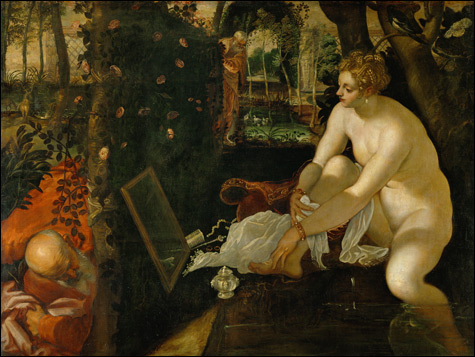
SUSANNAH AND THE ELDERS: Is the light that seems to impregnate Susannah streaming down from Heaven, or from Tintoretto? |
In a Bon Appétit essay a few years back, Alan Richman wrote, "There are two kinds of people in America: those who like Florence and those who like Venice." Boston has always been in the Florence camp. Florence is the Roman Empire and sun and bright light and primary colors and the primacy of the intellect. Not to mention Machiavelli, at whose feet Boston politicians seem to have learned their trade. Venice is the Orient and water and fog and refracted light and shifting colors and the pleasures of the body. In place of Machiavelli, it has Casanova.The Venetian palazzo that Isabella Stewart Gardner built for herself and that is now the Gardner Museum is an island of Venice in Florentine Boston. But it'll have company starting this Sunday, when the Museum of Fine Arts opens "Titian, Tintoretto, Veronese: Rivals in Renaissance Venice," a blockbuster show with 19 Titians, 18 Tintorettos, and 17 Veroneses. The MFA itself owns just two Titians (attribution of both in question), one Tintoretto (some of it by his workshop), and a few Veroneses, so landing this extravaganza, whose only other venue is the Louvre in Paris, was a coup.
The show's subtitle has overtones of "Three Venetian Artists," Venetian Idol, and a WAF (World Artists' Federation) smackdown, but the actual spin of "Titian, Tintoretto, Veronese" is that the trio — Titian born around 1488, Tintoretto in 1518, Veronese in 1528 — competed with one another for commissions, and that this rivalry affected the way their styles evolved. At the dawn of the 16th century, Italian painting began to move away from tempera and wood panel and toward oil and canvas, and there was a passing of the torch from Tuscany (which in the 15th century had spawned Fra Angelico, Masaccio, Piero della Francesca, Botticelli, Leonardo, and Michelangelo, to name a very few) to the Veneto, to Gentile and Giovanni Bellini and Giorgione. The relatively flat, spiritual, Neo-Platonic affect of the Florentine Quattrocento, with its firm line and religious certainties, gave way to the Venetian Cinquecento's play of water and light and texture, the sensuous luxury of oil paint, its broken line on canvas, and the sensuous luxury of the flesh — mostly women's.
At the MFA, "Titian, Tintoretto, Veronese" is set up as a series of face-offs involving two or three paintings, across five rooms: "New Rivals," "Sacred Themes," "Mythological Nudes" (framed by a pair of red damask curtains to suggest a bedroom), "Portraiture," and "Late Styles." There's a Supper at Emmaus from each artist, and a St. Jerome in the Wilderness, and the Tarquin and Lucretias from Titian and Tintoretto are juxtaposed with Veronese's Perseus and Andromeda. It's dizzying: curator Frederick Ilchman has snagged an improbable number of pairs and trios from the world's famous (and not so famous) museums.